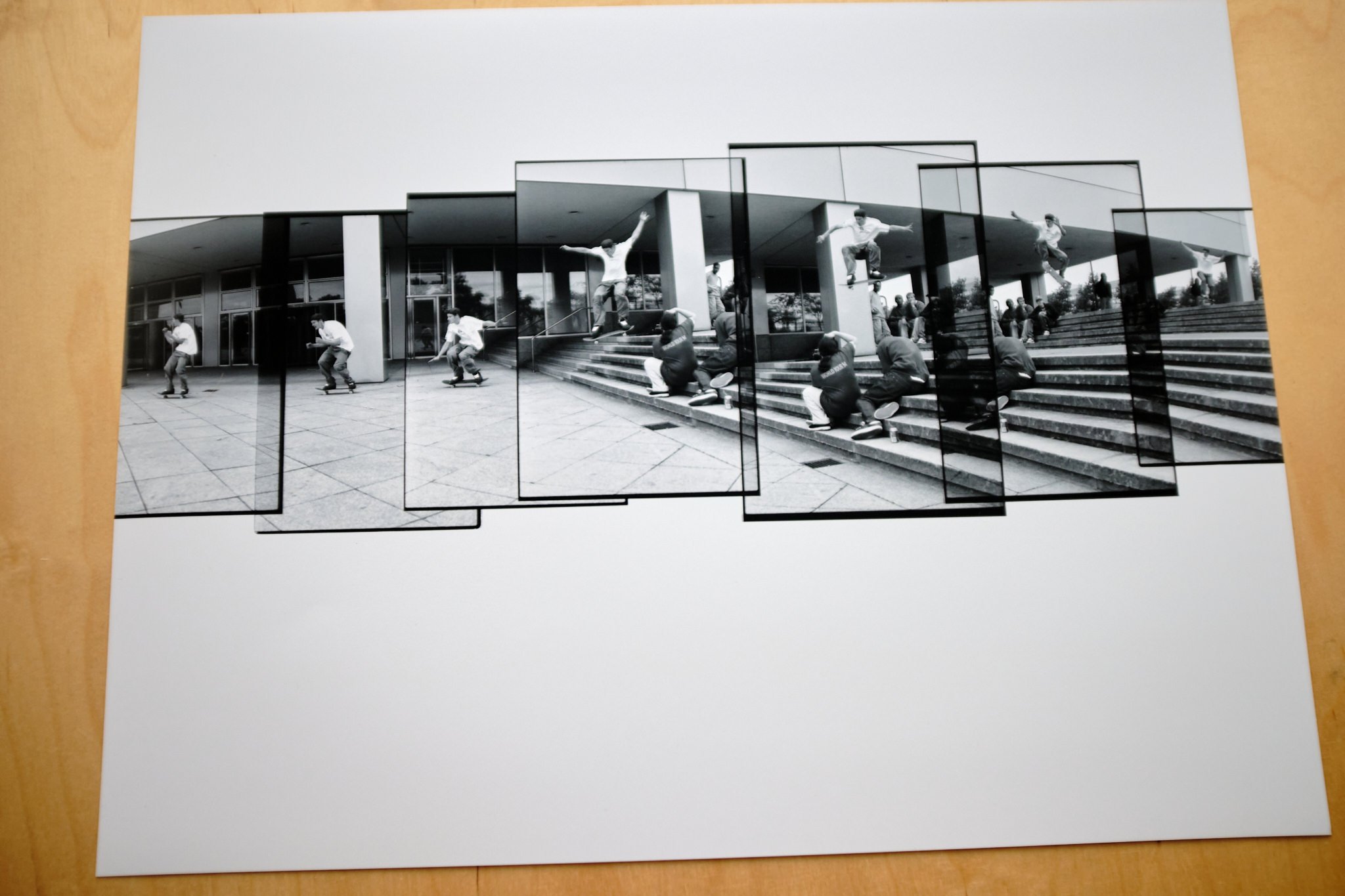Artist and Yorkshireman David Hockney started to shoot multiple instant photographs of a scene, placing them back together to create one picture in the late 1970's. Later switching away from the expensive Polaroid format and using 35mm film and relatively cheap small prints. These slotted together in just the same way in an attempt to create a feeling of direct involvement in the scene. As the series of pictures would somehow draw the viewer in. This may have been partially to do with the viewpoint perspective of the images as well as the way the eye works. Looking for detail in the different frames and taking clues as to whether they match or not.
I started to use this technique in the late 1990s when I was working for several skateboard magazines. In order to try and ‘escape the page’ or perhaps ‘move outside the box’ or some such other nonsense.
At the time my black and white printing practice was really quite good so I thought I would try to put multiple photographs back together in the dark room, printing them onto the same piece of paper.
Howard Cooke, Lower New Hall Place, Liverpool 1995.
Three negatives printed onto the same sheet of paper. Did anybody even notice that was what was going on?
One of the magazines I worked for had a deal with the film manufacturer Kodak at the time so it felt like film usage could be ‘unlimited’ to a degree.
Tom Summerall on the cover of Issue 39 of Sidewalk Magazine from August 1999.
Nobody would have known this was a joiner at the time. But this is one vertical frame and one horizontal frame merged together The designer of the magazine used the shapes of the two frames to create the shapes for the cover.
These ideas provided a way of trying to see beyond the limitations of the frame. Also rather than pulling back and using a wider view initially I could reframe and effectively have a higher resolution final result. This is something that really mattered at 300 dpi in printed magazines and not so much today as we view everything first and foremost on our relatively small mobile phone screens.
Scott Palmer, Lincoln’s Inns Fields, London. Late 1990s.
Two frame ‘joiner’ bottom left and top right.
Once again, did anybody notice this was a joiner at the time? Was I just driving the designers at the magazine nuts in my quest for just a bit more resolution?
Having started off by doing fairly obvious things that would just easily go back together I then tried to move onto things that would require more frames or an entire roll of film to work.
Pete Hellicar.
This idea is copied straight from something I had seen Spike Jonz do with Ray Barbee but with some added extra Hellicar ‘humour’.
Amon Tobin.
A rare opportunity to try and use a technique to try to reflect the character of a what I felt was a fairly angular and disjointed music producer in the 1990s.
Another idea that I took on and tried as often as possible was printing in steps from different frames to create a much more hand made look.
Tom Penny, final trick of his contest run in the finals at Radlands in 1994.
Original darkroom print made from torn up strips of paper and stuck back together. Really, very lo-fi.
Realising this treatment might have been to everyones taste, I sent the negatives of this to the magazine that I was working for at time as well as this composite print with a note suggesting that if they didn’t like what I’d made in the darkroom they could do something else. This print version ran across a double page.
Eventually of course the technique was “refined” by various action sports scenes, most notably, snowboarding and motocross with photographers using the infinite capabilities of the Photoshop graphics manipulation program in putting many frames back together without showing that they were doing so. This created a hyperreal look that never appealed to me but still lingers today.
I preferred the much more raw way of doing things and have returned to the archive recently to represent some pictures that I always wanted to look a certain way but never had the time to make them so.
Matthew Pritchard, Milton Keynes. 1994
Finally had a chance to put Matt back together in the way I originally saw it.
Many thanks to Dan Adams at Read and Destroy Archive and the Milton Keynes Skate Project for giving me the time and the opportunity to do this.
Channon King, Paternoster Steps, London. 1997.
This has been a long time in the making. These shots were originally used in a very different way in an advert for a skate shop in a skateboard magazine.
Then we reshot the entire thing using an entirely different technique.








